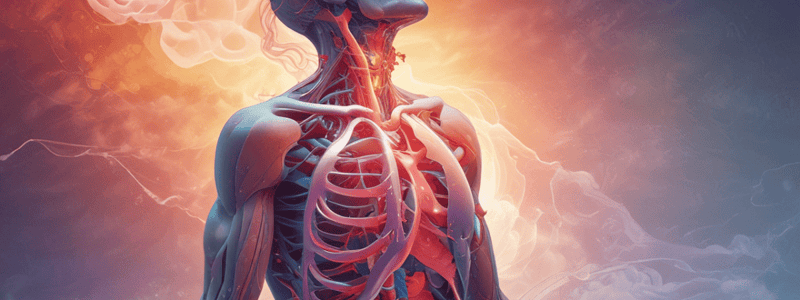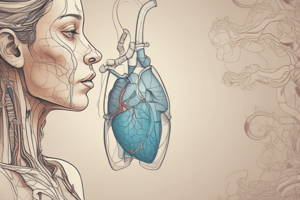Podcast
Questions and Answers
What is the primary function of oxygen in the metabolic processes of cells?
What is the primary function of oxygen in the metabolic processes of cells?
- To support cellular energy production (correct)
- To inhibit the production of haemoglobin
- To synthesize CO2 as a waste product
- To facilitate the release of CO2 into the plasma
In the capillary beds, what happens to oxygen?
In the capillary beds, what happens to oxygen?
- It is released into the plasma
- It is converted into CO2
- It is released into the tissues (correct)
- It is stored in the red blood cells
What is the primary route of CO2 transport from the tissues to the lungs?
What is the primary route of CO2 transport from the tissues to the lungs?
- Exclusively via plasma
- Mostly via plasma and partly via RBC (correct)
- Mostly via RBC and partly via plasma
- Exclusively via RBC
In the process of gas exchange, what happens to CO2 when it reaches the lungs?
In the process of gas exchange, what happens to CO2 when it reaches the lungs?
What is the role of haemoglobin in gas exchange?
What is the role of haemoglobin in gas exchange?
Oxygen is transported from the lungs to the tissues via the plasma in the capillaries.
Oxygen is transported from the lungs to the tissues via the plasma in the capillaries.
Carbon dioxide is released from the tissues directly into the plasma in the capillaries.
Carbon dioxide is released from the tissues directly into the plasma in the capillaries.
The primary mechanism of CO2 transport from the tissues to the lungs involves red blood cells.
The primary mechanism of CO2 transport from the tissues to the lungs involves red blood cells.
In the process of gas exchange, oxygen is released from the plasma in the capillaries to the tissues.
In the process of gas exchange, oxygen is released from the plasma in the capillaries to the tissues.
Carbon dioxide is produced by cells as a result of their metabolic processes.
Carbon dioxide is produced by cells as a result of their metabolic processes.
Leucocytes are responsible for carrying oxygen throughout the body.
Leucocytes are responsible for carrying oxygen throughout the body.
All leucocytes have granules in their cytoplasm.
All leucocytes have granules in their cytoplasm.
Leucocytes travel to the area of damage through the bloodstream.
Leucocytes travel to the area of damage through the bloodstream.
Leucocytes are produced by the damaged tissue itself.
Leucocytes are produced by the damaged tissue itself.
Leucocytes are responsible for healing the body.
Leucocytes are responsible for healing the body.
What is the primary function of leucocytes in the body?
What is the primary function of leucocytes in the body?
What is the difference between granulocytes and agranulocytes?
What is the difference between granulocytes and agranulocytes?
What signal triggers leucocytes to travel to the area of damage?
What signal triggers leucocytes to travel to the area of damage?
How do leucocytes travel to the area of damage?
How do leucocytes travel to the area of damage?
What happens to leucocytes when they reach the area of damage?
What happens to leucocytes when they reach the area of damage?
Leucocytes are responsible for carrying oxygen throughout the body.
Leucocytes are responsible for carrying oxygen throughout the body.
All leucocytes travel to the area of damage through the bloodstream.
All leucocytes travel to the area of damage through the bloodstream.
Granulocytes are WBC that lack granules in the cytoplasm.
Granulocytes are WBC that lack granules in the cytoplasm.
Leucocytes are produced by the bloodstream.
Leucocytes are produced by the bloodstream.
Leucocytes are triggered to travel to the area of damage by physical signals.
Leucocytes are triggered to travel to the area of damage by physical signals.
Match the type of leucocytes with their characteristic:
Match the type of leucocytes with their characteristic:
Match the location with the action of leucocytes:
Match the location with the action of leucocytes:
Match the function of leucocytes with the outcome:
Match the function of leucocytes with the outcome:
Match the source of signal with the response of leucocytes:
Match the source of signal with the response of leucocytes:
Match the type of leucocytes with their origin:
Match the type of leucocytes with their origin:
Match the type of granulocyte with its characteristic cytoplasmic granules:
Match the type of granulocyte with its characteristic cytoplasmic granules:
Match the type of granulocyte with its primary function:
Match the type of granulocyte with its primary function:
Match the type of granulocyte with its characteristic granules shape:
Match the type of granulocyte with its characteristic granules shape:
Match the type of granulocyte with its relative abundance:
Match the type of granulocyte with its relative abundance:
Match the type of granulocyte with its related condition:
Match the type of granulocyte with its related condition:
What is the primary function of T and B lymphocytes?
What is the primary function of T and B lymphocytes?
What happens to monocytes when they enter tissues?
What happens to monocytes when they enter tissues?
What do monocytes help lymphocytes with?
What do monocytes help lymphocytes with?
What is associated with chronic inflammation?
What is associated with chronic inflammation?
What are the two main types of lymphocytes?
What are the two main types of lymphocytes?
Lymphocytes are directly involved in chronic inflammation
Lymphocytes are directly involved in chronic inflammation
There is only one type of B lymphocyte
There is only one type of B lymphocyte
Monocytes become lymphocytes when they enter tissues
Monocytes become lymphocytes when they enter tissues
T lymphocytes are responsible for making antibodies
T lymphocytes are responsible for making antibodies
Agranulocytes have granules in their cytoplasm
Agranulocytes have granules in their cytoplasm
What is a characteristic of granules in the cytoplasm of WBCs?
What is a characteristic of granules in the cytoplasm of WBCs?
How can the size of WBCs be compared to RBCs for identification?
How can the size of WBCs be compared to RBCs for identification?
What is a characteristic of a WBC that lacks granules in its cytoplasm?
What is a characteristic of a WBC that lacks granules in its cytoplasm?
What is the primary reason for comparing the size of WBCs to RBCs?
What is the primary reason for comparing the size of WBCs to RBCs?
What is a characteristic of the nucleus of a WBC compared to the cell size?
What is a characteristic of the nucleus of a WBC compared to the cell size?
What is the meaning of the term thrombo?
What is the meaning of the term thrombo?
What is the function of thrombocytes?
What is the function of thrombocytes?
What is the term for the stopping of blood flow?
What is the term for the stopping of blood flow?
What is the term for blood-related?
What is the term for blood-related?
What is the function of haemostasis?
What is the function of haemostasis?
What is the primary goal of haemostasis?
What is the primary goal of haemostasis?
What is the role of clotting/coagulation factors in haemostasis?
What is the role of clotting/coagulation factors in haemostasis?
What is the first step in the haemostasis process?
What is the first step in the haemostasis process?
What is the origin of clotting/coagulation factors in the blood?
What is the origin of clotting/coagulation factors in the blood?
What are the two main stages of haemostasis?
What are the two main stages of haemostasis?




